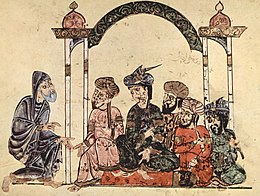Raqs sharqi
| This article is part of a series on |
| Life in Egypt |
|---|
 |
| Culture |
| Society |
| Politics |
| Economy |
|
Egypt portal |
| Part of a series on |
| Arabic culture |
|---|
 |

Raqs sharqi (Arabic: رقص شرقي, Egyptian Arabic: [ˈɾɑʔsˤ ˈʃæɾʔi]; literally "oriental dancing") is the classical Egyptian style of belly dance that developed during the first half of the 20th century.
History
[edit]Raqs sharqi was developed by Taheyya Kariokka, Samia Gamal, Naima Akef, Zeinat Olwi, and other dancers who rose to fame during the golden years of the Egyptian film industry. This has come to be considered the classical style of dance in Egypt by the 1950s. These dancers were famous not only for their role in Egyptian films, but also for their performances at the "Opera Casino" opened in 1925 by Badia Masabni. This venue was a popular place for influential musicians and choreographers from both the US and Europe, so many of the developments pioneered here can be considered new developments in the dance.

Later dancers who were influenced by these artists are Soheir Zaki, Nagwa Fouad, Fifi Abdou, and Dalilah. All rose to fame between 1960 and 1980, and are still popular today. And later generations, such as Dina, some of these later dancers were the first to choreograph and perform dances using a full 'orchestra' and stage set-up, which had a huge influence upon what is considered the 'classical' style.
Though the basic movements of raqs sharqi are unchanged, the dance form continues to evolve. Nelly Mazloum and Mahmoud Reda are noted for incorporating elements of ballet, and their influence can be seen in modern Egyptian dancers who stand on relevé as they turn or travel in a circle or figure eight.
Costume
[edit]Since the 1950s, it has been illegal in Egypt for belly dancers to perform publicly with their midriff uncovered[1] or to display excessive skin. It is therefore becoming more common to wear a long, figure-hugging lycra one-piece gown with strategically placed cut-outs filled in with sheer, flesh-coloured fabric. If a separate bra and skirt are worn, a belt is rarely used and any embellishment is embroidered directly on the tight, sleek lycra skirt. A sheer body stocking must be worn to cover the midsection. Egyptian dancers traditionally dance in bare feet, but these days often wear shoes and even high heels.
Respectability in Egypt
[edit]Generally, Egyptians do not consider Raks Sharki to be a respectable profession, despite attempts by several groups to change the perception. Many Egyptians also continue to employ native Egyptian dancers for wedding receptions and other celebratory events. Strict moral laws prevent a lot of local Egyptian dancers from performing in public spaces so many dancers performing for tourists in nightclubs today are foreigners.
Belly dancers in Egypt have restrictions placed on their costume and movements. Most notably, no floor work is permitted and the dancer's midriff must be covered. However, many Egyptian nightclubs don't necessarily follow the government guidelines.
In 2009, a plan to establish a state institute to train belly dancers in Egypt came under heavy fire as it "seriously challenges the Egyptian society's traditions and glaringly violates the constitution", said Farid Esmail a member of the parliament, a thing that was widely viewed by many Egyptian celebrities and dancers as hate against Egyptian arts.[2]
Difference in interpretation of different countries
[edit]Depending on the country where this dance is performed, the style of Raqs Sharqi has its own peculiarities of subtlety.[3][4]
Lebanese style.[5] The movements differ from the Egyptian style, the presence of a large expression, and the ankle movements as well. Use of the diaphragm muscles when performing this dance on the floor. In Lebanon, graceful dancers are favored. Character is expressed more in Lebanese dance and the music is more dynamic.[6]
The Turkish style is called Oriental Tansi.[7][8] The main difference is in the amount of movement. Egyptian dancers move during the dance slowly and thinking through each movement, and the movements of Turkish dancers on the contrary are fervent. This style is very energetic and it even includes acrobatic elements. Dancers often dance on the floor. In Egypt, this style of Oriental dancing was banned and soon lost popularity altogether.
Oriental is performed to Egyptian music. The "pure genre" uses classics - classic Egyptian rhythms, with or without song. Modern Egyptian pop can be used for show performances (in restaurants, for example).
Naturally, music has a great influence on dance. In Turkish Lebanese styles, Raqs Sharqi is accompanied by the same instruments with the only difference being the rhythm.
The costume of Turkish dancers is different from that of Egyptian dancers. Turkish bedla skirts are more ornate than Egyptian skirts and side slits are used more often.[9]
References
[edit]- ^ Hanna, Judith (1988). Dance, Sex and Gender. Chicago: University of Chicago Press. ISBN 0-226-31551-7.
- ^ Move to teach art in state institute triggers controversy Archived 8 August 2009 at the Wayback Machine
- ^ "Belying The Belly Dancer: Misconceptions of Raqs Sharqi That Need to Be Corrected In Your Writing". www.sfwa.org. Retrieved 6 August 2024.
- ^ "What is Egyptian Raqs Sharqi and Cabaret Style". www.worldbellydance.com. Retrieved 6 August 2024.
- ^ "Lebanese style Belly Dancing - Raqs Sharqi Lubnani". www.atlantabellydance.com. Retrieved 6 August 2024.
- ^ "Raqs Sharqi". www.artemisyadancewear.com. Retrieved 6 August 2024.
- ^ "The Raqs Sharqi Museum Collections". www.badriyahbellydance.com. Retrieved 6 August 2024.
- ^ "The Rich Heritage of Arab Belly Dancing". playaling.com. Retrieved 6 August 2024.
- ^ "Where in the World is Raqs Sharqi: Costuming". missbellydance.com. Retrieved 6 August 2024.
External links
[edit] Media related to Raqs sharqi at Wikimedia Commons
Media related to Raqs sharqi at Wikimedia Commons
